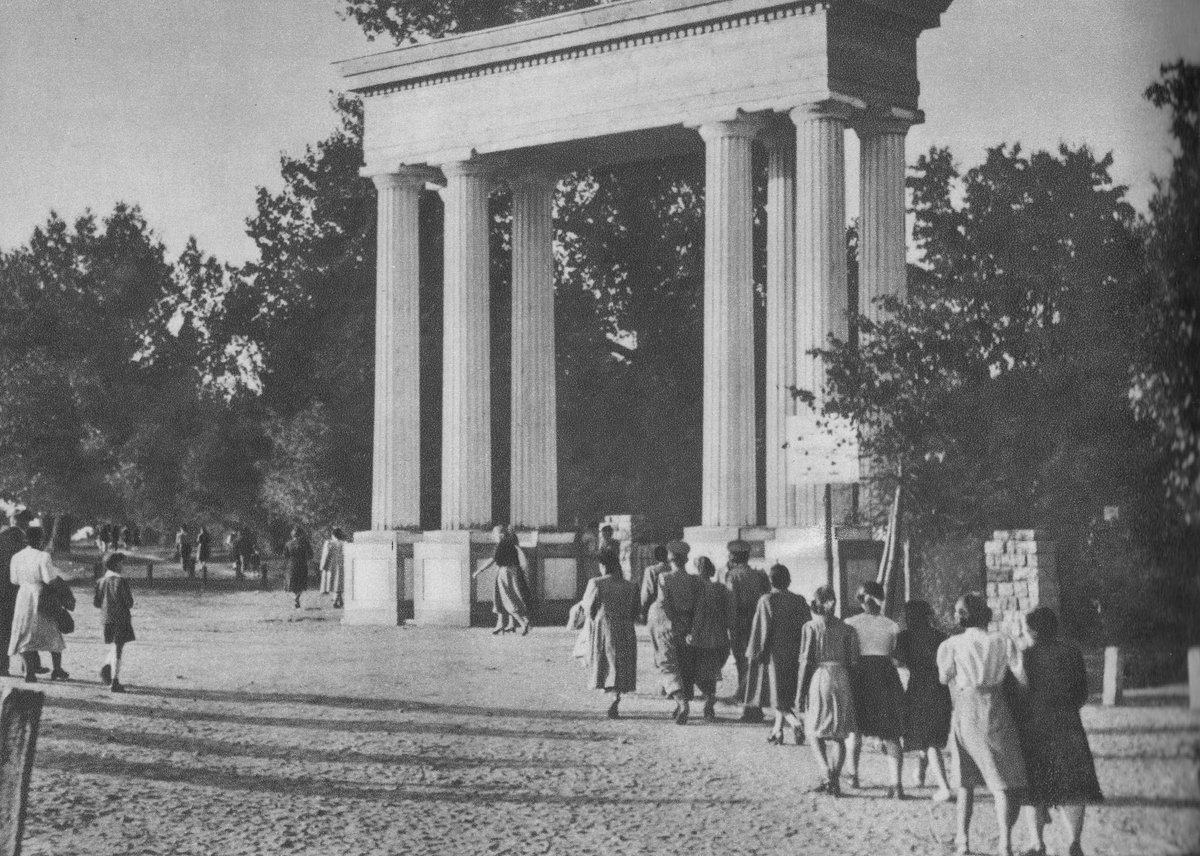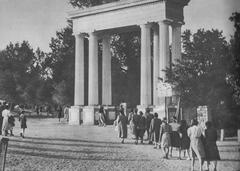
Rezerwat Przyrody Las Bielański Visiting Hours, Tickets, and Historical Significance
Date: 19/07/2024
Introduction
Nestled within the bustling city of Warsaw, Rezerwat Przyrody Las Bielański (Bielany Forest Nature Reserve) stands as a unique destination that offers a blend of rich history, ecological diversity, and cultural significance. This urban forest, one of the largest in Europe, serves as a green oasis amid the metropolis, providing an escape into nature for both residents and visitors. The history of Las Bielański is deeply intertwined with that of Warsaw, dating back to the 12th century when it was part of the vast Mazovian Forest. Over centuries, it evolved from a royal hunting ground and a site of religious significance with the Camaldolese Monastery, to a protected nature reserve in 1973. Today, the forest is celebrated not only for its historical landmarks but also for its rich biodiversity, which includes a variety of plant and animal species. This comprehensive guide will delve into the history, ecological importance, visitor information, and special features of Las Bielański, ensuring that your visit is both enriching and enjoyable. (Warsaw University Botanical Garden, Polish Academy of Sciences Botanical Garden, Warsaw Parks and Greenery Department, Warsaw Ornithological Society, Mammal Research Institute, Polish Academy of Sciences, Museum and Institute of Zoology, Polish Academy of Sciences)
Table of Contents
- Introduction
- History and Significance of Rezerwat Przyrody Las Bielański
- Exploring the Flora and Fauna of Rezerwat Przyrody Las Bielański
- Visitor Information
- Special Features
- Visitor Tips and Accessibility
- FAQ
- Conclusion
History and Significance of Rezerwat Przyrody Las Bielański
A Forest Through the Ages
The history of Las Bielański (Bielany Forest) is deeply intertwined with the history of Warsaw itself. While the city bustles around it, the forest stands as a living testament to centuries past, its ancient trees whispering tales of times gone by.
-
Early Beginnings (12th Century - 16th Century) - The forest’s story begins in the 12th century, long before Warsaw became the bustling capital it is today. Originally known as “Puszcza Mazowiecka” (Mazovian Forest), it was a vast wilderness teeming with life. The first settlements began to appear on its edges, eventually giving rise to the village of Bielany, from which the forest takes its present name.
-
A Royal Retreat (17th Century) - In the 17th century, Polish kings, particularly Władysław IV Vasa, recognized the beauty and tranquility of the forest. They designated it as a royal hunting ground, and it became a popular spot for courtly retreats. The construction of the Camaldolese Monastery in 1654 further cemented the forest’s connection to the Polish monarchy.
-
A Place of Pilgrimage and Resilience (18th - 19th Centuries) - The Camaldolese Monastery, with its iconic white towers, became a significant pilgrimage site. The monks, known for their strict lifestyle and devotion, played a crucial role in preserving the forest. They carefully managed its resources and protected it from overexploitation. Even during times of war and upheaval, such as the Partitions of Poland, the forest remained a symbol of Polish identity and resilience.
-
A Protected Oasis (20th Century - Present) - In 1973, recognizing its ecological and historical significance, Las Bielański was officially designated as a nature reserve (Rezerwat Przyrody). This designation aimed to protect its unique ecosystem and preserve its historical character for future generations. Today, it stands as one of the largest urban forests in Europe, a green lung within the bustling metropolis of Warsaw.
Ecological, Historical, Cultural, and Recreational Significance
Las Bielański is far more than just a green space within the city. Its significance is multifaceted, encompassing ecological, historical, cultural, and recreational values.
Ecological Significance
As a nature reserve, Las Bielański is a haven for biodiversity. It is home to a wide variety of plant and animal species, some of which are rare or endangered. The forest’s mature trees, some centuries old, play a vital role in cleaning the air and regulating the microclimate of the surrounding area.
Historical Significance
The forest stands as a living reminder of Warsaw’s past. The Camaldolese Monastery, with its rich history and stunning architecture, is a testament to the city’s royal and religious heritage. The forest’s very landscape, shaped by centuries of human interaction, tells a story of changing times and enduring resilience.
Cultural Significance
Las Bielański holds a special place in the hearts of Warsaw’s residents. It is a place where city dwellers can escape the urban hustle and reconnect with nature. The forest is a popular destination for walks, bike rides, and picnics, offering a much-needed respite from city life. It also hosts various cultural events and festivals throughout the year, further enriching the cultural fabric of the city.
Recreational Significance
Beyond its natural beauty, Las Bielański offers a range of recreational opportunities. Well-maintained trails wind through the forest, providing opportunities for hiking, jogging, and cycling. There are designated picnic areas, playgrounds, and even an outdoor gym. The forest is also a popular spot for birdwatching and nature photography.
Exploring the Flora and Fauna of Rezerwat Przyrody Las Bielański
Rezerwat Przyrody Las Bielański, despite its location within Warsaw city limits, boasts a surprisingly diverse ecosystem. This richness in flora and fauna makes it a haven for nature enthusiasts visiting the Polish capital.
Flora - A Tapestry of Trees and Shrubs
The reserve is dominated by a mix of deciduous and coniferous forests, creating a visually appealing tapestry of greens and browns throughout the year.
Deciduous Giants
- Pedunculate oak (Quercus robur) and hornbeam (Carpinus betulus) - These majestic trees, some reaching over 250 years old, form the majority of the canopy and provide a glimpse into the area’s ancient past. (Warsaw University Botanical Garden)
Coniferous Resilience
- Scots pine (Pinus sylvestris) - Scattered amongst the deciduous giants, their evergreen needles offer a splash of color even during the winter months. Occasional European larch (Larix decidua) adds to the forest structure’s diversity. (Polish Academy of Sciences Botanical Garden)
Understory Diversity
- Hazel (Corylus avellana) and hawthorn (Crataegus monogyna) - The forest floor thrives with a rich understory featuring these shrubs, providing food and shelter for various animal species. (Warsaw Parks and Greenery Department)
Fauna - A Haven for Urban Wildlife
The diverse plant life within Rezerwat Przyrody Las Bielański supports a surprising array of animal life. While larger mammals are less common due to the reserve’s urban setting, the area teems with smaller creatures and a vibrant bird population.
Avian Symphony
- Birdwatchers - Over 70 bird species have been recorded, including woodpeckers, owls, and various songbirds. Look for the Eurasian jay (Garrulus glandarius), whose vibrant blue plumage adds a splash of color. (Warsaw Ornithological Society)
Mammals in the Shadows
- Small mammals - Squirrels, hedgehogs, and even weasels find refuge here, playing a vital role in the forest ecosystem. (Mammal Research Institute, Polish Academy of Sciences)
Insects and Amphibians
- Damp areas and fallen logs - Habitats for various insects and amphibians, like colorful dragonflies and croaking frogs, indicators of a healthy and balanced ecosystem. (Museum and Institute of Zoology, Polish Academy of Sciences)
Visitor Information
Visiting Hours and Tickets
- Opening hours - The reserve is open daily from dawn to dusk.
- Tickets - Entry is free, but guided tours may have associated costs. Check the official website for the latest updates.
Travel Tips
- Getting there - Easily accessible by public transport or car. Parking is available nearby.
- Best time to visit - Spring and autumn offer the most vibrant displays of flora and fauna.
- Nearby attractions - Combine your visit with nearby historical sites like the Warsaw Uprising Museum or the Royal Castle.
Special Features
Special Events
Throughout the year, the forest hosts various events, including cultural festivals, guided nature walks, and educational workshops. Check the official website for the event calendar.
Guided Tours
For a deeper understanding of the forest’s history and biodiversity, consider joining a guided tour. Knowledgeable guides provide insights into the unique aspects of Las Bielański.
Photographic Spots
The forest is a photographer’s paradise with picturesque landscapes, historical landmarks, and diverse wildlife. Be sure to bring your camera to capture the beauty of Las Bielański.
Visitor Tips and Accessibility
Best Time to Visit
- Spring (April-May) - Witness the forest floor come alive with blooming wildflowers, particularly wood anemones. The weather is mild, making it ideal for leisurely walks.
- Summer (June-August) - Enjoy the lush greenery and warm weather, perfect for picnics and exploring the forest trails. However, expect more crowds during this peak season.
- Autumn (September-October) - Experience the vibrant fall foliage as the leaves transform into a breathtaking palette of colors. The crisp air adds to the magical ambiance.
What to Wear
- Comfortable walking shoes - The forest trails can be uneven and muddy, especially after rain. Sturdy footwear is essential.
- Layered clothing - Be prepared for changing weather conditions, even during warmer months. A light jacket or sweater can be useful.
- Insect repellent - Mosquitoes and ticks can be present, especially during summer. Protect yourself with appropriate repellent.
What to Bring
- Water bottle - Stay hydrated, especially during warmer days. There are limited drinking water sources within the reserve.
- Snacks or picnic basket - Enjoy a relaxing break amidst nature. Remember to pack out all your trash to help preserve the environment.
- Camera - Capture the beauty of the forest and its inhabitants. Don’t forget to charge your batteries beforehand.
- Binoculars (optional) - Enhance your birdwatching experience by bringing a pair of binoculars to observe the diverse avian species.
- Map (optional) - While the trails are generally well-marked, a map can be helpful for navigating the reserve and discovering hidden spots.
Trails and Facilities
- Marked Trails - The reserve features a network of well-marked trails suitable for different fitness levels. Choose from easy, moderate, or challenging routes based on your preference.
- Accessibility for People with Disabilities - Some trails are partially accessible to people with disabilities. However, due to the natural terrain, certain areas may pose challenges. It’s recommended to contact the reserve administration for specific accessibility information.
- Rest Areas and Benches - Benches are strategically placed along the trails, providing opportunities to rest and enjoy the surroundings.
- Restrooms - Public restrooms are available near the main entrance.
FAQ
What are the Las Bielański visiting hours?
Las Bielański is open year-round. For specific hours, check the official website.
Is there an entry fee for Las Bielański?
No, entry to Las Bielański is free.
How can I get to Las Bielański?
The forest is easily accessible by public transport from various parts of Warsaw.
Are guided tours available?
Yes, guided tours are available and provide valuable insights into the forest’s history and ecology.
Conclusion
Rezerwat Przyrody Las Bielański is a treasure trove of history, nature, and culture. It is a place where the past and present intertwine, offering visitors a unique and enriching experience. Whether seeking solace in nature, exploring historical landmarks, or simply enjoying the outdoors, Las Bielański has something to offer everyone. Plan your visit today and immerse yourself in the beauty and history of this remarkable urban forest. For more information and updates, don’t forget to download our mobile app Audiala, check out related posts, or follow us on social media. (Warsaw University Botanical Garden, Polish Academy of Sciences Botanical Garden, Warsaw Parks and Greenery Department, Warsaw Ornithological Society, Mammal Research Institute, Polish Academy of Sciences, Museum and Institute of Zoology, Polish Academy of Sciences)
References
- Warsaw University Botanical Garden. https://ogrod.uw.edu.pl/en/
- Polish Academy of Sciences Botanical Garden. http://www.ogrod-powsin.pl/en/
- Warsaw Parks and Greenery Department. https://zzp.waw.pl/en/
- Warsaw Ornithological Society. https://warszawa.birdwatching.pl/en/
- Mammal Research Institute, Polish Academy of Sciences. https://zbs.bialowieza.pl/en/
- Museum and Institute of Zoology, Polish Academy of Sciences. https://www.miiz.waw.pl/en/

































































































































































